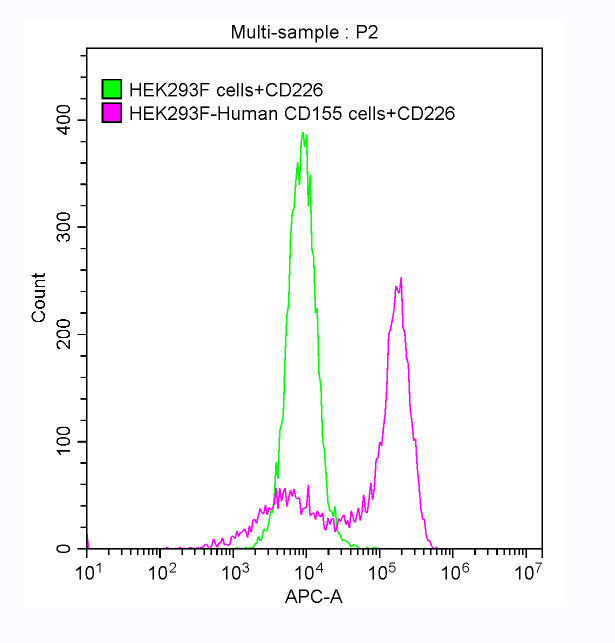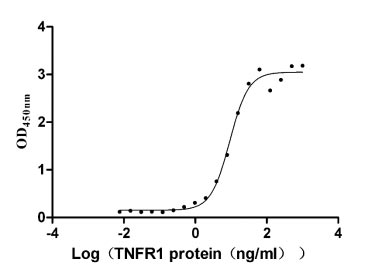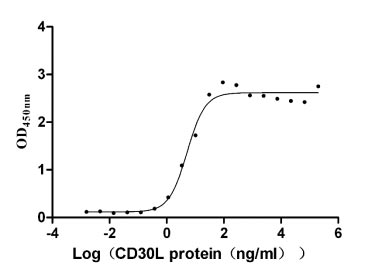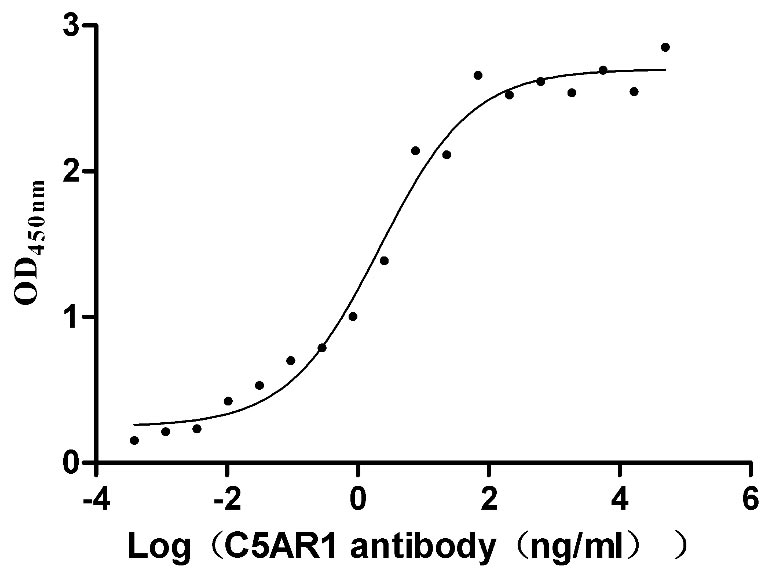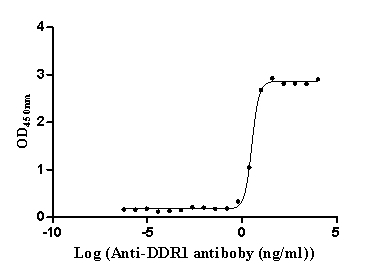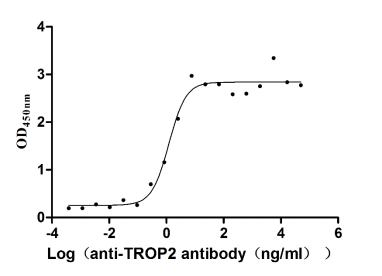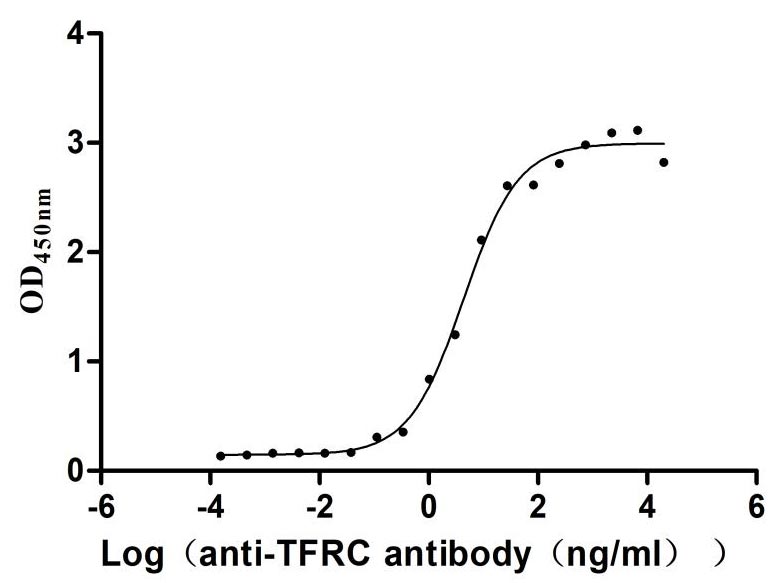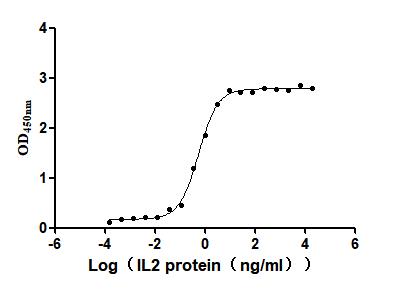Recombinant Human Adhesion G-protein coupled receptor G1 (ADGRG1 GPR56 TM7LN4 TM7XN1 UNQ540/PRO1083)
-
中文名稱:
-
貨號:CSB-YP812970HU
-
規格:
-
來源:Yeast
-
其他:
-
中文名稱:
-
貨號:CSB-EP812970HU
-
規格:
-
來源:E.coli
-
其他:
-
中文名稱:
-
貨號:CSB-EP812970HU-B
-
規格:
-
來源:E.coli
-
共軛:Avi-tag Biotinylated
E. coli biotin ligase (BirA) is highly specific in covalently attaching biotin to the 15 amino acid AviTag peptide. This recombinant protein was biotinylated in vivo by AviTag-BirA technology, which method is BriA catalyzes amide linkage between the biotin and the specific lysine of the AviTag.
-
其他:
-
中文名稱:
-
貨號:CSB-BP812970HU
-
規格:
-
來源:Baculovirus
-
其他:
-
中文名稱:
-
貨號:CSB-MP812970HU
-
規格:
-
來源:Mammalian cell
-
其他:
產品詳情
-
純度:>85% (SDS-PAGE)
-
基因名:AGRG1
-
Uniprot No.:
-
別名:Adhesion G-protein coupled receptor G1; G-protein coupled receptor 56; [Cleaved into: Adhesion G-protein coupled receptor G1, N-terminal fragment; ADGRG1 N-terminal fragment; ADGRG1 NT; GPR56 N-terminal fragment; GPR56 NT; GPR56(N; GPR56 extracellular subunit; GPR56 subunit alpha; Adhesion G-protein coupled receptor G1, C-terminal fragment; ADGRG1 C-terminal fragment; ADGRG1 CT; GPR56 C-terminal fragment; GPR56 CT; GPR56(C; GPR56 seven-transmembrane subunit; GPR56 7TM; GPR56 subunit beta] ADGRG1 GPR56 TM7LN4 TM7XN1 UNQ540/PRO1083
-
種屬:Homo sapiens (Human)
-
蛋白標簽:Tag?type?will?be?determined?during?the?manufacturing?process.
The tag type will be determined during production process. If you have specified tag type, please tell us and we will develop the specified tag preferentially. -
產品提供形式:Liquid or Lyophilized powder
Note: We will preferentially ship the format that we have in stock, however, if you have any special requirement for the format, please remark your requirement when placing the order, we will prepare according to your demand. -
復溶:We recommend that this vial be briefly centrifuged prior to opening to bring the contents to the bottom. Please reconstitute protein in deionized sterile water to a concentration of 0.1-1.0 mg/mL.We recommend to add 5-50% of glycerol (final concentration) and aliquot for long-term storage at -20℃/-80℃. Our default final concentration of glycerol is 50%. Customers could use it as reference.
-
儲存條件:Store at -20°C/-80°C upon receipt, aliquoting is necessary for mutiple use. Avoid repeated freeze-thaw cycles.
-
保質期:The shelf life is related to many factors, storage state, buffer ingredients, storage temperature and the stability of the protein itself.
Generally, the shelf life of liquid form is 6 months at -20°C/-80°C. The shelf life of lyophilized form is 12 months at -20°C/-80°C. -
貨期:Delivery time may differ from different purchasing way or location, please kindly consult your local distributors for specific delivery time.Note: All of our proteins are default shipped with normal blue ice packs, if you request to ship with dry ice, please communicate with us in advance and extra fees will be charged.
-
注意事項:Repeated freezing and thawing is not recommended. Store working aliquots at 4°C for up to one week.
-
Datasheet :Please contact us to get it.
相關產品
靶點詳情
-
功能:Receptor involved in cell adhesion and probably in cell-cell interactions. Mediates cell matrix adhesion in developing neurons and hematopoietic stem cells. Receptor for collagen III/COL3A1 in the developing brain and involved in regulation of cortical development, specifically in maintenance of the pial basement membrane integrity and in cortical lamination. Binding to the COL3A1 ligand inhibits neuronal migration and activates the RhoA pathway by coupling to GNA13 and possibly GNA12. Plays a role in the maintenance of hematopoietic stem cells and/or leukemia stem cells in bone marrow niche. Plays a critical role in cancer progression by inhibiting VEGFA production threreby inhibiting angiogenesis through a signaling pathway mediated by PRKCA. Plays an essential role in testis development.; Plays a critical role in cancer progression by activating VEGFA production and angiogenesis through a signaling pathway mediated by PRKCA.
-
基因功能參考文獻:
- High GPR56 expression is associated with metastasis via epithelialmesenchymal transition carcinoma in colorectal cancer. PMID: 30066935
- The authors conclude that soluble GPR56 is present in vivo and is elevated in certain chronic inflammatory diseases such as rheumatoid arthritis. Hence, soluble GPR56 might be considered a potential biomarker for rheumatoid arthritis disease progression. PMID: 28690029
- Our data suggest that collagen III may be effective in optimising islet function to improve islet transplantation outcomes, and GPR56 may be a target for the treatment of type 2 diabetes PMID: 29855662
- that GPR56 might be an inhibitor of the mesenchymal transition across multiple tumor types beyond glioblastoma PMID: 29166609
- We report a clinical feature, electroclinical findings, and clinical course of a patient with a severe phenotype of MCPH2 including microcephaly, refractory infantile spasms and intellectual disability. We detected a new homozygous splicing variant c.3335+1G>C in the WD repeat domain 62 (WDR62) gene, and an additional new heterozygous missense mutation c.1706T>A of G protein-coupled receptor 56 (GPR56) gene PMID: 28756000
- Stachel-independent modulation of GPR56/ADGRG1 signaling by synthetic ligands directed to its extracellular region. PMID: 28874577
- Brain MRI in the affected siblings as well as in the two previously reported individuals with bi-allelic COL3A1 mutations showed a brain phenotype similar to that associated with mutations in GPR56. PMID: 28258187
- GPR56 inhibits natural cytotoxicity of human NK cells. PMID: 27184850
- Functional relevance of GPR56 expression was validated in mice, in which co-expression of Gpr56 significantly accelerated HOXA9-induced leukemogenesis PMID: 27063597
- expression and activation of GPR56 may modulate melanoma progression in part by inducing IL-6 production after N-terminal fragment dissociation and C-terminal fragment self-activation PMID: 27818281
- Disease-associated extracellular loop mutations in the adhesion G protein-coupled receptor G1 (ADGRG1; GPR56) differentially regulate downstream signaling PMID: 28424266
- GPR56 regulates the proliferation and invasion capacity of osteosarcoma cells. PMID: 27396430
- High GPR56 expression was significantly associated with high-risk genetic subgroups and poor outcome in patients with acute myeloid leukemia and identifies cancer stem cells with high repopulating potential. PMID: 26834243
- Data suggest that agonist-induced signal transduction via either GPR56/ADGRG1 or BAI1/ADGRB1 does not require conserved membrane-proximal stalk region of these proteins; ADGRG1 may participate in stalk-dependent and stalk-independent signaling. PMID: 26710850
- Agonistic antibodies reveal the function of GPR56 in human glioma U87-MG cells PMID: 25832639
- we knocked down GPR56 in cardiomyocytes and found that GPR56 promoted Ang II-induced cardiomyocyte hypertrophy and it contributed to PCBP2 effects on cardiomyocyte hypertrophy PMID: 26116532
- GPR56 and GPR110 are activated by exposure of a cryptic tethered agonist PMID: 25918380
- These findings demonstrate that reduced expression of GPR56 in lung fibroblasts may be an important link with pulmonary fibrosis, playing a role in regulating some important fibroblast functions. PMID: 24742924
- Data show that Gpr56, a G-coupled protein receptor, is required for hematopoietic cluster formation during transdifferentiation process in endothelial to hematopoietic cell transition (EHT). PMID: 25547674
- these data reveal a mechanism by which control of GPR56 expression pattern by multiple alternative promoters can influence stem cell proliferation, gyral patterning, and, potentially, neocortex evolution. PMID: 24531968
- GPR56, MT1G, and RASSF1 might be the potential methylation markers associated with acquired multidrug resistance of lung adenocarcinoma. PMID: 23902976
- Loss of GPR56 is associated with abnormal muscle development. PMID: 24102982
- GPR56 may represent an important GPCR for the maintenance of HSCs by acting as a co-ordinator of interactions with the BM osteosteal niche. PMID: 23478665
- The present study confirms the phenotypic overlap between GPR56-related brain dysgenesis and other cobblestone-like syndromes. PMID: 23274687
- Disease-associated mutations prevent GPR56-collagen III interaction. PMID: 22238662
- study reports a novel missense mutation of GPR56, E496K, identified in a consanguineous pedigree with bilateral frontoparietal polymicrogyria PMID: 21723461
- GPR56 expression is a common trait of human cytotoxic lymphocytes and might affect the migratory properties of these cells. PMID: 21724806
- The N terminus of the adhesion G protein-coupled receptor GPR56 controls receptor signaling activity. PMID: 21708946
- consistent with its suppressive roles in melanoma progression, the expression levels of GPR56 are inversely correlated with the malignancy of melanomas in human subjects PMID: 21724588
- GPR56 mutations cause bilateral frontoparietal polymicrogyria via multiple mechanisms PMID: 21349848
- Results suggest that the splicing of GPR56 may induce differential tumorigenic responses owing to their varied ability to activate transcription factors. PMID: 19572147
- A significant correlation between GPR56, TG2, and NF-kappaB was observed that correlated with nodal metastasis and tumor invasion in esophageal squamous cell carcinoma. PMID: 20874003
- Identify GPR56 as a novel marker capable of discriminating different natural killer cells subsets. PMID: 20008459
- results show that mutations in GPR56 cause a human brain cortical malformatin called bilateral frontoparietal polymicrogyria (BFPP); data suggest that GPR56 signaling plays an essential role in regional development of human cerebral cortex PMID: 15044805
- Increased expression of GPCR56 is associated with esophageal squamous cell carcinoma PMID: 15916848
- Results show that GPR56 binds specifically to tissue transglutaminase, TG2, a widespread component of tissue and tumor stroma previously implicated as an inhibitor of tumor progression. PMID: 16757564
- Review describes the expression of a ligand that interacts with GPR56 in metastatic melanoma cells as TG2, a major crosslinking enzyme in the tumor extracellular matrix. PMID: 17314516
- These results define the biochemical properties of GPR56 protein, and suggest that the expression of GPR56 protein is suppressed in human pancreatic cancer cells. PMID: 17932623
- We have shown that GPR56 GPS mutant protein is defective in cleavage and surface localization, while non-GPS mutant proteins are cleaved normally but still defective in surface localization. PMID: 18042463
- This study reported that three consanguineous families in which four affected individuals with Bilateral frontoparietal polymicrogyria and GPR56 mutations had Lennox-Gastaut syndrome. PMID: 19016831
- Our data suggest that GPR56 can be used as an NSC/NPC marker within the neural cell lineage, especially in combination with nestin. PMID: 19525879
顯示更多
收起更多
-
相關疾病:Polymicrogyria, bilateral frontoparietal (BFPP); Polymicrogyria, bilateral perisylvian, autosomal recessive (BPPR)
-
亞細胞定位:Cell membrane; Multi-pass membrane protein.; [ADGRG1 N-terminal fragment]: Secreted.; [ADGRG1 C-terminal fragment]: Membrane raft.
-
蛋白家族:G-protein coupled receptor 2 family, LN-TM7 subfamily
-
組織特異性:Widely distributed with highest levels found in thyroid gland, brain and heart. Expressed in a great number of tumor cells. Expression is down-regulated in different tumors from highly metastatic cells.
-
數據庫鏈接:
Most popular with customers
-
Recombinant Human CD226 antigen (CD226), partial (Active)
Express system: Mammalian cell
Species: Homo sapiens (Human)
-
Recombinant Human Tumor necrosis factor receptor superfamily member 1A (TNFRSF1A), partial (Active)
Express system: Mammalian cell
Species: Homo sapiens (Human)
-
Recombinant Human Tumor necrosis factor ligand superfamily member 8 (TNFSF8), partial (Active)
Express system: Mammalian cell
Species: Homo sapiens (Human)
-
Recombinant Human C5a anaphylatoxin chemotactic receptor 1 (C5AR1)-VLPs (Active)
Express system: Mammalian cell
Species: Homo sapiens (Human)
-
Recombinant Human Epithelial discoidin domain-containing receptor 1 (DDR1), partial (Active)
Express system: Mammalian cell
Species: Homo sapiens (Human)
-
Recombinant Human Tumor-associated calcium signal transducer 2 (TACSTD2), partial (Active)
Express system: Mammalian cell
Species: Homo sapiens (Human)
-
Recombinant Human Transferrin receptor protein 1 (TFRC), partial (Active)
Express system: Mammalian cell
Species: Homo sapiens (Human)
-
Recombinant Human Interleukin-2 (IL2) (Active)
Express system: Mammalian cell
Species: Homo sapiens (Human)


